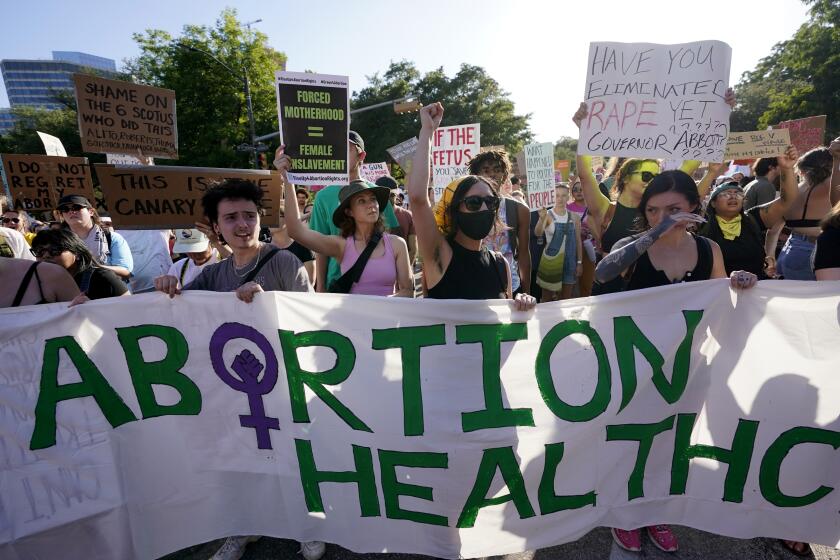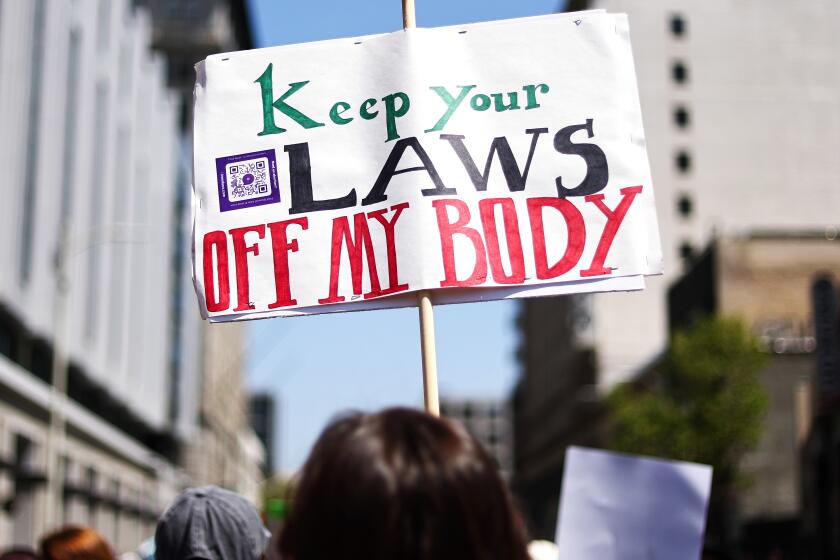Editorial: Ohio lawmakers want to subvert democracy to stop voters from protecting abortion access. Shame on them

Ohio is the latest state in which voters will decide whether to enshrine in the state constitution the right to abortion that was struck down by the U.S. Supreme Court last year.
Abortion access advocates in that state say they have submitted more than enough signatures to put a constitutional amendment on the November ballot to protect the right to an abortion up to fetal viability — or beyond, if necessary to protect the health of a pregnant person. They were required to collect 413,000 valid signatures of voters across the state. Last week, they turned in nearly 710,000 signatures. “Toward the end it was difficult to find someone who hadn’t signed it,” said Gabriel Mann, from the advocacy coalition, Ohioans for Reproductive Freedom.
When the Supreme Court overturned Roe vs. Wade and returned the decision on abortion to the states, reproductive rights advocates took that directive seriously.
Last year, about half a dozen states across the political spectrum — blue, purple and red — voted either to secure reproductive rights through state constitutional amendments or to reject ballot measures that would have specified that state constitutions don’t protect abortion rights. Those elections in California, Vermont, Michigan, Kansas and Kentucky demonstrated what poll after poll has shown: Most Americans support at least access to abortion during the first trimester, even in states with antiabortion legislatures.
When the Supreme Court overturned this ruling last year, it sent the issue of reproductive rights to the states, where the fight over access has been waged ever since -- and will continue into coming years.
But even if the Ohio secretary of state confirms that enough valid signatures were submitted, the vote on the Right to Reproductive Freedom with Protections for Health and Safety Amendment may be thwarted by an anti-democratic effort by the Ohio Legislature. The state’s lawmakers recently passed Issue 1, a ballot measure to raise the threshold for passage of constitutional amendments from a simple majority to 60%.
The Legislature also wedged in a special election for that measure on Aug. 8 — just a few months ahead of a regularly scheduled November election. If the measure passes (and it only needs a simple majority), it would raise the number of votes needed to adopt the abortion amendment.
This is an outrageous ploy to erect an unreasonable hurdle for supporters of reproductive rights to benefit an intolerant minority. Ohio has had a simple majority requirement for citizen-initiated constitutional amendments for decades. Of the 18 states that allow citizen-initiated constitutional amendments, most require only a simple majority to pass. That is the case in California. Less than a handful of states require more than a simple majority. The Florida Legislature successfully put a measure on the ballot in 2006 to raise the number of votes needed to pass constitutional amendments to 60% after environmentalists had gotten an initiative creating a high-speed rail system passed and animal welfare advocates won passage of an amendment guaranteeing minimum living space for pregnant pigs.
Ohio Secretary of State Frank LaRose — who has in the past said he wants to raise the threshold for voting on constitutional amendments — told a group this year that there’s one reason why he’s supporting the current measure: “This is 100% about keeping a radical pro-abortion amendment out of our constitution.”
The Ohio measure would also change the requirement that signatures gathered for a citizen-initiated constitutional amendment come not just from half of the state’s 88 counties, but from all of them. That would make Ohio the only state with such a requirement.
A year after the Supreme Court’s Dobbs decision, abortion foes want more, even if most Americans disagree.
The states that voted to protect abortion rights last year did so with majorities below 60%. (Although Kansas came close with 59% voting against a measure that would have prohibited the constitution from protecting abortion rights.) If Issue 1 passes, it could be more difficult for Ohio to get the reproductive rights amendment over that threshold in November.
And Ohioans need constitutional protection for abortion. A six-week abortion ban passed by the Legislature in 2019 went into effect briefly after Roe was overturned and then was blocked by the courts, but that could change. Currently, abortion is legal in Ohio roughly up to 22 weeks of gestation with various other restrictions.
But before they even get to vote on reproductive rights, Ohioans need to go to the polls in August to make sure Issue 1 doesn’t pass. Its only reason for being on the ballot is to make it harder for people to protect the abortion rights that lawmakers would like to take away.
The Supreme Court returned decision-making on abortion rights to the states. But that doesn’t mean making it inordinately hard for voters to protect the rights they value. Ohio voters need to make sure their legislators get that message on Aug. 8.
More to Read
A cure for the common opinion
Get thought-provoking perspectives with our weekly newsletter.
You may occasionally receive promotional content from the Los Angeles Times.












